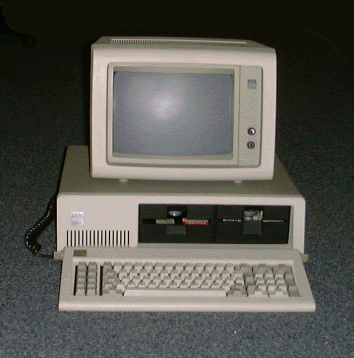IBM Personal Computer
UvA Computer Museum catalogue nr 98.25

The IBM-PC was built around the Intel 8088 (clocked at 4.77 MHz) which was essentially a 16 bits processor (similar to the 8086) but used a multiplexed 8-bits bus system. In this way it was possible to reduce the complexity of the motherboard, at the same time about halving the machine's performance, of course. Optionally (!) there were two 160K single-sided floppy disk drives; an audiocassette interface for data storage was standard. The PC could be used with a monochrome (green) alphanumeric display or a graphics display using 16 colors. Accidentely interchanging these monitors - they used the same type of connector - could have fatal consequences.
The PC had Cassette BASIC in ROM which was sufficient to run the machine, with a cassette for mass storage. Alternatively one could use Disk BASIC or Advanced BASIC which required the Microsoft Disk Operating System (disk meaning floppy-disk!). PC-DOS occupied 12 kB of memory, therefore at least 32 kB of memory was needed, twice the standard amount. Our own PC had an unbelievable 512 kB of RAM, plus a 10 MB hard disk, which was mounted in a separate box (not shown). The system and extension units were connected by a half-inch thick cable.
The IBM-PC shown was donated by the Chemistry Department of the University of Amsterdam (Mr. H. Agema).
